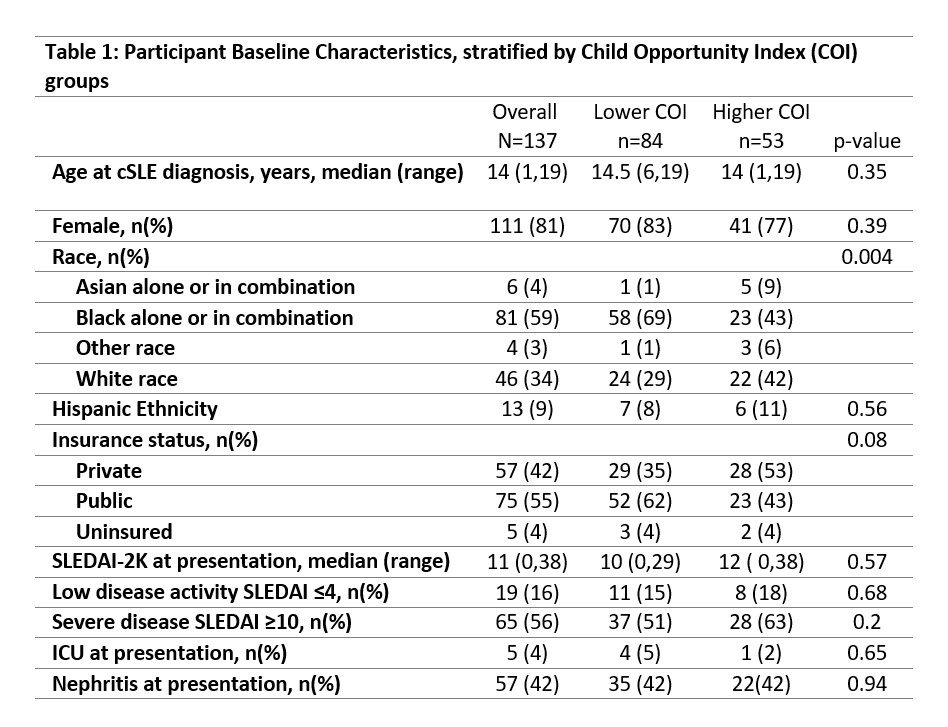Session Information
Session Type: Poster Session B
Session Time: 10:30AM-12:30PM
Background/Purpose: Outcomes for systemic lupus erythematosus are known to be associated with sociodemographic indicators. The Child Opportunity Index (COI) is a well-validated measure of neighborhood characteristics associated with healthy child development. This study compares patient-level sociodemographic variables and childhood-onset systemic lupus erythematosus (cSLE) disease activity at presentation between COI groups.
Methods: This retrospective study included 137 cSLE patients with clinical visits at a single tertiary care center from 2017 to 2022. Participants were stratified into two COI-based groups: “lower” (combined low and very low quintiles) and “higher” (combined moderate, high, and very high quintiles). Univariate analysis compared baseline demographic variables and SLEDAI-2K at presentation across COI groups using Chi-square and Fisher’s exact for categorical variables and Kruskal-Wallis for continuous variables.
Results: The median age of cSLE at diagnosis was 14 years, and 76% were female (Table1). Race showed a statistically significant difference, with a higher proportion of Black non-Hispanic patients in the lower COI group (69% vs, 43%, p=0.004). Insurance status neared significance, with a higher percentage of publicly insured patients in the low COI group (62 vs. 43, p=0.08). The median (range) SLEDAI at diagnosis was 11 (0, 38) and 19% of the overall cohort had an SLEDAI of ≤4 at presentation. The median (range) SLEDAI-2K score was 10 (0, 29) for the lower COI group and 12 (0,38) for the higher COI group. Sixteen percent had low disease activity (SLEDAI-2K ≤4) at presentation, with no difference between COI groups (15% lower vs 18% higher, p=0.68). Over half (56%) had severe disease activity (SLEDAI-2K ≥10), which also did not differ significantly by COI (51% lower vs 63% higher, p=0.2).
Conclusion: This study provides an initial analysis of patient-level sociodemographic disparities that exist across COI groups in cSLE patients. Preliminarily, there are no significant association that were found between COI and cSLE disease activity at presentation. Ongoing analysis of longitudinal data will further investigate if COI impacts achieving treat-to-target outcomes in cSLE patients.
To cite this abstract in AMA style:
Eltoum A, Timmerman L, Mannion M, Smitherman E. The Relationship Between Child Opportunity Index and Burden of Pediatric Systemic Lupus Erythematosus [abstract]. Arthritis Rheumatol. 2024; 76 (suppl 9). https://acrabstracts.org/abstract/the-relationship-between-child-opportunity-index-and-burden-of-pediatric-systemic-lupus-erythematosus/. Accessed .« Back to ACR Convergence 2024
ACR Meeting Abstracts - https://acrabstracts.org/abstract/the-relationship-between-child-opportunity-index-and-burden-of-pediatric-systemic-lupus-erythematosus/

